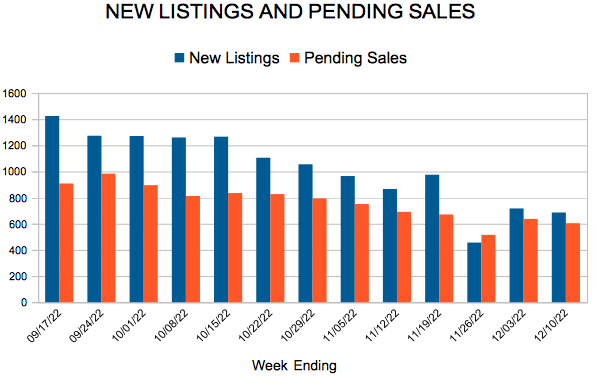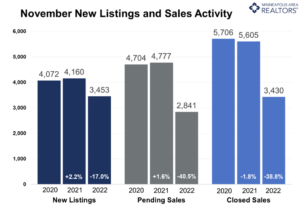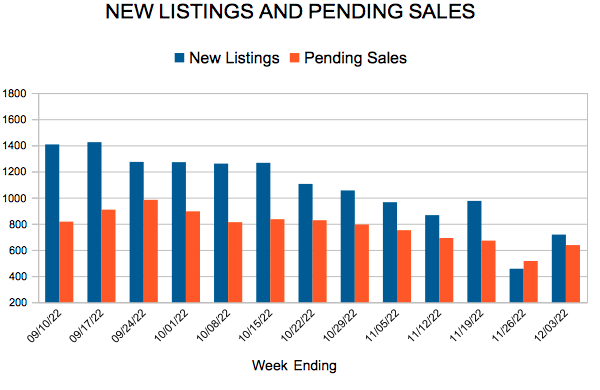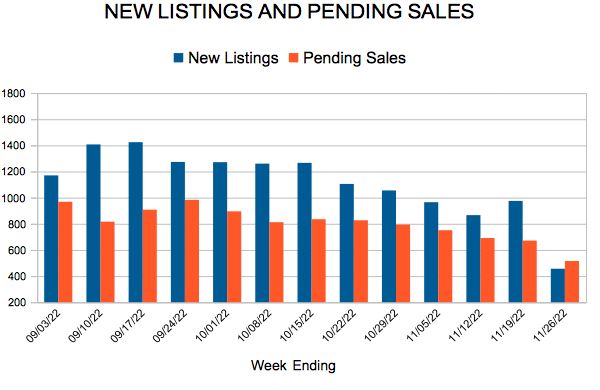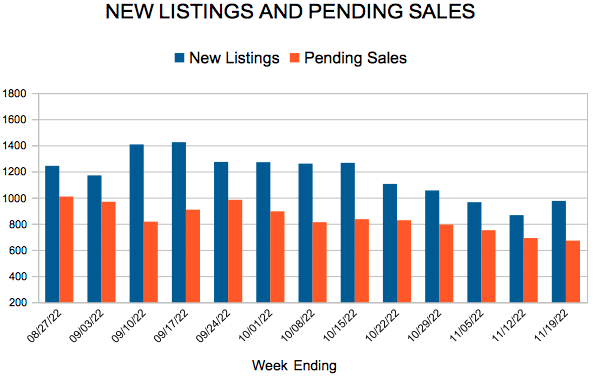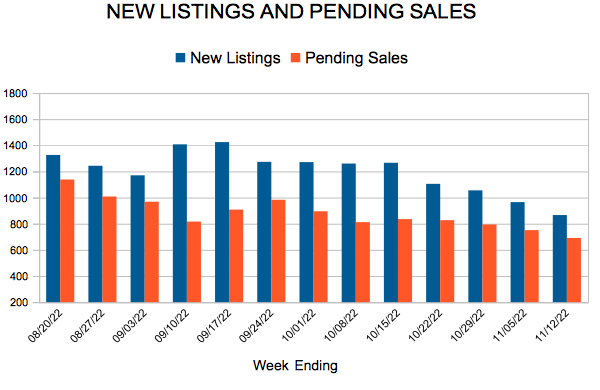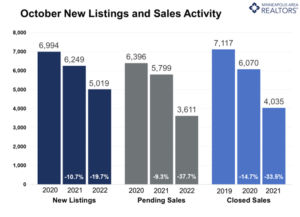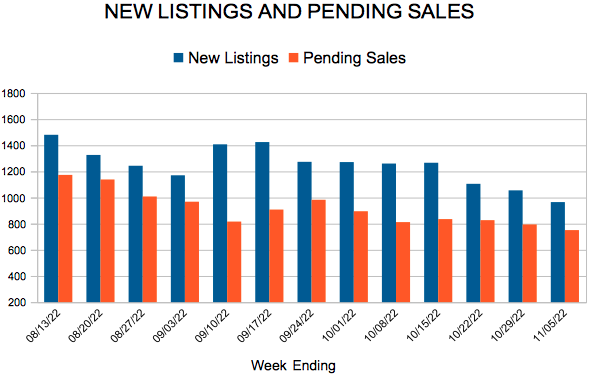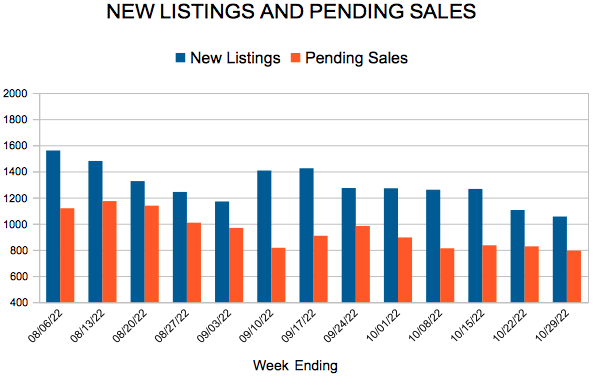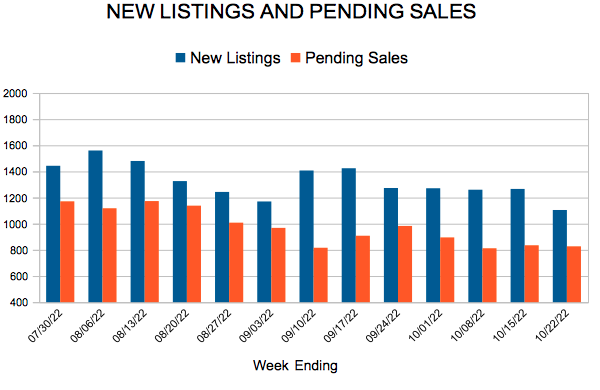Sales down and inventory up amid slowing price growth
- Buyer activity down 40.5 percent with 2,841 pending sales
- Median sales price of Twin Cities homes rose 4.1 percent to $354,000
- Sellers continued to hesitate, with 17.0 percent fewer new listings in November
(December 15, 2022) – According to new data from Minneapolis Area REALTORS® and the Saint Paul Area Association of REALTORS®, the metro saw its largest drop in year over year home sales this November, largely due to increased mortgage interest rates combined with unprecedented buyer activity in the fourth quarter of 2021.
SALES & LISTINGS
Real estate activity has cooled across the United States after a series of significant rate hikes by the Federal Reserve designed to slow borrowing in an effort to combat rising inflation. For residential real estate, that’s meant higher mortgage rates and monthly payments, which can push homeownership further out of reach for some buyers. Last month, buyers signed 2,841 purchase agreements, a staggering 40.5 percent fewer than last year and the lowest November figure in over a decade. Only 3,430 transactions closed, down 38.8 percent, which meant sellers had to be more flexible.
“Sellers are hesitant to put their home on the market because their payments would be very different,” according to Denise Mazone, President of Minneapolis Area REALTORS®. “In most cases, sellers are also then buyers, and many have chosen to stay put for now until things settle down, instead of trading up to a higher payment on a more expensive home.”
There were 3,453 homes listed in November, 17.0 percent fewer listings than November 2021. Sellers should understand that—unlike last year—they may not receive dozens of offers above asking price within hours or days of listing. Last month, half of all sellers sold homes for no more than 98.4 percent of their original listing price compared to 99.8 percent last year. Additionally, they accepted those offers after an average of 40 days on market. It’s not just the higher costs on the next home that’s concerning today’s sellers; they will need to be more patient, be willing to accept a bit less than asking price, and be prepared to sweeten the deal and/or possibly help cover some closings costs—very different dynamics than a year ago.
INVENTORY & HOME PRICES
The median home price in the Twin Cities increased by 4.1 percent to $354,000. Compared to a couple months with 10.0 percent year-over-year price growth in 2022, this moderate increase is more aligned with the historic average in the Twin Cities. While price growth is slowing, the overall direction of home prices has been positive throughout the year.
“One factor that’s kept home prices rising modestly is that seller activity has come down in tandem with sales,” said Mark Mason, President of the Saint Paul Area Association of REALTORS®. “Moderating price growth should be seen as a sign of a more sustainable market in line with longer-term trends.”
The softening in buyer activity meant 12.6 percent more homes remained on the market at month-end, closing out November with 7,629 units in inventory. Yet more supply is still needed. The metro only has 1.7 month’s supply of inventory. Typically 4-6 months of supply are needed to reach a balanced market.
LOCATION & PROPERTY TYPE
Market activity varies by area, price point and property type. New home sales fell 18.7 percent while existing home sales were down 40.2 percent. Single family sales fell 39.2 percent, condo sales declined 30.9 percent and townhome sales were down 35.3 percent. Sales in Minneapolis decreased 34.4 percent while Saint Paul sales fell 37.9 percent. Cities like Hutchinson, Medina, and Little Canada saw the largest sales gains while Savage, Monticello and Roseville all had notably lower demand than last year.
NOVEMBER 2022 HOUSING TAKEAWAYS (COMPARED TO A YEAR AGO)
- Sellers listed 3,453 properties on the market, a 17.0 percent decrease from last November
- Buyers signed 2,841 purchase agreements, down 40.5 percent (3,430 closed sales, down 38.8 percent)
- Inventory levels grew 12.6 percent to 7,629 units
- Month’s Supply of Inventory rose 41.7 percent to 1.7 months (4-6 months is balanced)
- The Median Sales Price rose 4.1 percent to $354,000
- Days on Market rose 33.3 percent to 40 days, on average (median of 24 days, up 50.0 percent)
- Changes in Sales activity varied by market segment
- Single family sales decreased 39.2 percent; Condo sales were down 30.9 percent & townhouse sales fell 35.3 percent
- Traditional sales declined 38.5 percent; foreclosure sales rose 40.0 percent; short sales rose 150.0 percent (2 to 5 units)
- Previously owned sales decreased 40.2 percent; new construction sales declined 18.7 percent
New Listings and Pending Sales
New Listings and Pending Sales
New Listings and Pending Sales
New Listings and Pending Sales
Higher rates continue to cool sales while prices continue their ascent
- Buyer activity dropped 37.7 percent with 3,611 pending sales
- Median sales price of Twin Cities homes rose 4.7 percent to $356,002
- 30-Year mortgage rates are averaging around 7.0 percent, the highest since 2002
(November 15, 2022) – According to new data from Minneapolis Area REALTORS® and the Saint Paul Area Association of REALTORS®, pending sales were down by over a third in October compared to last year. The decline in buyer activity is largely a response to increased mortgage interest rates and many completing purchases in the last couple years. Meanwhile, home prices continue their ascent.
SALES & LISTINGS
Several rate hikes by the Federal Reserve have had their desired effect: to slow borrowing activity and slow the demand for capital. This has significantly cooled home sales activity across the nation, including in the Twin Cities. In October, buyers saw their mortgage interest rates increase to 7.1 percent, a 20-year record. Facing higher monthly payments (about 35.0 percent higher), buyers were reluctant to sign contracts. Pending sales fell 37.7 percent to 3,611 purchase agreements and 4,035 transactions closed, down 33.5 percent. The Twin Cities has not seen a year-over-year decline in demand this substantial since the summer of 2010.
“We quickly forget how the last two years were extraordinary and historic years for housing. There will always be a lull after that. But these rates are exacerbating this,” according to Denise Mazone, President of Minneapolis Area REALTORS®. “The reality is that this is a more typical market but doesn’t feel that way compared to the last few years. Sellers getting 104.0% of their list price in 4 hours with 40 offers is neither normal nor sustainable.”
Seller activity was also down as many hesitated to become buyers and trade in their favorable rates for higher payments. Softer demand has meant homes spend more time on the market—36 days on average or nine days longer than last October but one day longer than 2020. Sellers listed 5,019 properties on the market, 19.7 percent fewer than this time in 2021. Those that did list tended to accept a smaller share of their asking price, averaging 98.2 percent of list price.
INVENTORY & HOME PRICES
The median home price in the Twin Cities increased by 4.7 percent to $356,002. While up, the increase is down from some double-digit price gains in 2020 and 2021. In fact, it’s the smallest increase since the onset of the pandemic. Although the rate of price growth is slowing, prices continue rising as both the homes and buyers in the market skew toward higher price points. Inventory levels remain tight despite the recent shifts toward a more balanced market. The softening in demand has been met with a similar decline in new listings, keeping the balance relatively tight.
“Between changing rates, inflation, an election and a possible recession, there’s a lot of uncertainty in the air right now,” said Mark Mason, President of the Saint Paul Area Association of REALTORS®. “Despite all that, our region still has thousands of eager buyers every month searching for their next home.” October ended with 8,756 homes for sale, 5.1 percent more than last year. Weaker buyer activity has shifted our industry back towards a more balanced marketplace (4-6 months of supply), but buyers should understand we are still in a seller’s market. Month’s supply of inventory rose 26.7 percent to 1.9 months.
LOCATION & PROPERTY TYPE
Market activity varies by area, price point and property type. New home sales fell 18.3 percent while existing home sales were down 33.8 percent. Single family sales fell 32.2 percent, condo sales declined 36.4 percent and townhome sales were down 33.1 percent. Sales in Minneapolis decreased 30.0 percent while Saint Paul sales fell 33.4 percent. Cities like Corcoran, Elko New Market, St. Paul Park and Belle Plaine saw the largest sales gains while Princeton, Centerville, East Bethel and North St. Paul all had notably lower demand than last year.
For more information on weekly and monthly housing numbers visit www.mplsrealtor.com or www.spaar.com
OCTOBER 2022 HOUSING TAKEAWAYS (COMPARED TO A YEAR AGO)
- Sellers listed 5,019 properties on the market, a 19.7 percent decrease from last October
- Buyers signed 3,611 purchase agreements, down 37.7 percent (4,035 closed sales, down 33.5 percent)
- Inventory levels grew 5.1 percent to 8,756 units
- Month’s Supply of Inventory rose 26.7 percent to 1.9 months (4-6 months is balanced)
- The Median Sales Price rose 4.7 percent to $356,002
- Days on Market rose 33.3 percent to 36 days, on average (median of 22 days, up 57.1 percent)
- Changes in Sales activity varied by market segment
- Single family sales decreased 32.2 percent; Condo sales were down 36.4 percent & townhouse sales fell 33.1 percent
- Traditional sales declined 33.1 percent; foreclosure sales rose 45.0 percent; short sales were unchanged from last year
- Previously owned sales decreased 33.8 percent; new construction sales declined 18.3 percent
New Listings and Pending Sales
New Listings and Pending Sales
New Listings and Pending Sales
- « Previous Page
- 1
- …
- 14
- 15
- 16
- 17
- 18
- …
- 28
- Next Page »

